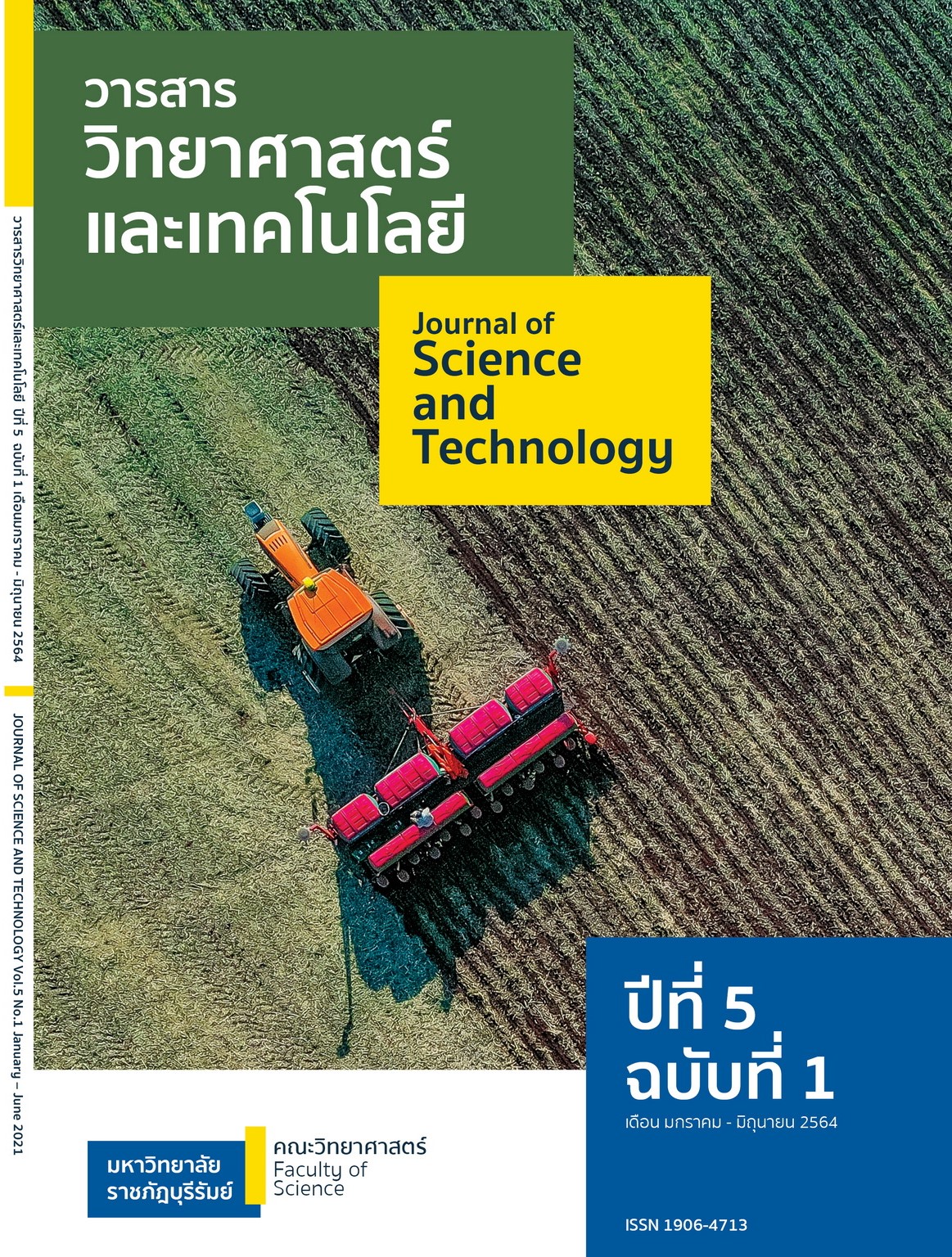การกำหนดเพศด้วยการคัดแยกอสุจิในโค
Main Article Content
บทคัดย่อ
บทความทางวิชาการฉบับนี้เรียบเรียงขึ้นจากผลงานวิจัยในอดีตที่พยายามทำให้การคัดแยกอสุจิให้มีเฉพาะ X หรือ Y โครโมโซมซึ่งเมื่อนำอสุจินี้ไปใช้ก็จะทำให้ได้ลูกโคที่มีเพศตรงตามความต้องการของเกษตรกร วิธีการคัดแยกอสุจิที่มีความแม่นยำที่สุด คือ การคัดแยกด้วย Flow cytometry/ cell sorter วิธีนี้อาศัยหลักการที่ว่าอสุจิที่มี X มีปริมาณ DNA มากกว่าอสุจิที่มี Y โครโมโซมราว 4 % การแยกอสุจิทำได้ย้อมสี DNA ด้วย Hoeschst 33342 ซึ่งจะให้สีเรืองแสงสีน้ำเงินเมื่อได้รับแสงเลเซอร์ที่มีความยาวคลื่น 351 - 364 nm อสุจิที่มี X โครโมโซม เรืองแสงมากกว่าอสุจิที่มี Y โครโมโซม เมื่อนำอสุจิที่ย้อมเข้าสู่เครื่องsorter จะสามารถแยกเก็บอสุจิที่มี X โครโมโซม Y โครโมโซม ออกจากกันโดยมีความแม่นยำในการคัดแยกประมาณ 90 % เครื่อง sorterสามารถคัดแยกได้ 32,000 อสุจิ/วินาที หลังกระบวนการแยกจะได้อสุจิที่มี X และ Y โครโมโซม อย่างละ 8,000 อสุจิ/วินาที ถ้าบรรจุน้ำเชื้อหลอดละ 2 ล้านตัว จะสามารถผลิตได้ 14 หลอด/แต่ละเพศ ในหนึ่งชั่วโมง วิธีการนี้สามารถนำมาใช้ในเชิงการค้าได้ น้ำเชื้อแยกเพศสามารถนำไปใช้เพื่อการผสมเทียมได้ทั้งโคนม และโคเนื้อ การใช้ผสมเทียมโคสาว มีความเหมาะสมกว่าการใช้ในแม่โค อาจมีการเหนี่ยวนำให้โคตกไข่พร้อมกัน (FTAI) เพื่อง่ายต่อการจัดการผสมเทียม น้ำเชื้อแยกเพศเหมาะต่อการนำไปใช้เพื่อการผลิตตัวอ่อนก่อนการย้ายฝากเพื่อให้ได้ลูกโคที่มีเพศตรงตามความต้องการ การใช้น้ำเชื้อแยกเพศช่วยย่นระยะเวลาในการปรับปรุงพันธุ์โค และส่งผลต่อรายได้ที่เพิ่มขึ้นภายในฟาร์มของเกษตรกร
Article Details
เนื้อหาและข้อมูลในบทความที่ลงตีพิมพ์ในวารสารวารสารวิทยาศาสตร์และเทคโนโลยีถือเป็นข้อคิดเห็นและความรับผิดชอบของผู้เขียนบทความโดยตรงซึ่งกองบรรณาธิการวารสาร ไม่จำเป็นต้องเห็นด้วย หรือร่วมรับผิดชอบใด ๆ
บทความ ข้อมูล เนื้อหา รูปภาพ ฯลฯ ที่ได้รับการตีพิมพ์ในวารสารวารสารวิทยาศาสตร์และเทคโนโลยีถือเป็นลิขสิทธิ์ของวารสารวารสารวิทยาศาสตร์และเทคโนโลยีหากบุคคลหรือหน่วยงานใดต้องการนำทั้งหมดหรือส่วนหนึ่งส่วนใดไปเผยแพร่ต่อหรือเพื่อกระทำการใด ๆ จะต้องได้รับอนุญาตเป็นลายลักษณ์อักษรจากวารสารวารสารวิทยาศาสตร์และเทคโนโลยี ก่อนเท่านั้น
เอกสารอ้างอิง
Beernink, F.J., W.P. Dmowski and R.J. Ericsson. 1993. Sex preselection through albumin separation of sperm. Fertility and Sterility, 59: 382-386.
Blottener, S., H. Nehring., W. Jenichem and W. Peter. 1983. Use of carrier free deflection electrophoresis in experiments for separation of sperm genotypes. Arch. Exp. Veterinamed. 37: 641-655.
Check, J.H., B.S. Shanis., S.O. Cooper and A. Bollendorf. 1989. Male sex preselection: swim-up technique and insemination of woman after ovulation induction. Archives of andrology, 23: 165-166.
Chen, X., H. Zhu., C. Wu., W. Han H. Hao,. X. Zhao et al. 2012. Identification of differentially expressed proteins between bull x and Y spermatozoa. Journal of Proteonics, 77:59-67.
Ericsson, R.J., C.N. Langevan and M. Nishino. 1973. Isolation of fraction rich in Y spermatozoa. Nature, 245:421-424.
Garner, D.L. and G.E. Seidel. 2003. Past, present and future perspectives on sexing sperm. Can. J. Anim. Sci. 83:375-384.
Hall J.B. and J.B. Glaze. 2014. Sexed semen – how it is produced and how can we use it efficiently. Proceedings of the 2014 Applied Reproductive strategies in beef cattle conference. Available at: https://beefrepro.org/wp-content/uploads/2020/09/Hall_John.pdf. Access date: 11-1-2020.
Herrmann, B.G., B. Koschorz., K. Wertz., K.J. McLaughlin and A. Kispert. 1999. A protein kinase encoded by the t complex responder gene cause non-Mendelian inheritance. Nature, 402: 141-146.
Holden, S.A. and S.T. Butler. 2018. Review Application and benefits of sexed semen in dairy and beef herds. Animal. 12; S1: s97-s103.
Hoppe, P.C. and G.C. Koo. 1984. Reacting mouse sperm with monoclonal H-Y antibodies does not influence sex ratio pf eggs fertilized in vitro. Journal of Reproductive Immunology. 6:1-9.
Johnson, L.A., G.R. Welch and W. Rens. 1999. The Beltsville sperm sexing technology: high-speed sperm sorting gives improved sperm output for in vitro fertilization and AI. J. Anim. Sci. 77: 213-220.
Kumar, N., B. Gebrekidan., T.T. Gebrewahd and B. Hadush. 2017. Sexed semen technology in cattle. Indian Journal of Animal Health. 56(2): 157-168.
Li, C.J., D. Wang and X. Zhou. 2016. Sperm proteome and reproductive technologies in mammals. Animal Reproduction science. 173:1-7.
Marques, M. O., F. Morotti., E. Lorenzetti., C. Bizarro-Silva and M.M. Seneda. 2018. Intensified use of TAI and sexed semen on commercial farms. Anim. Reprod. 15(3): 197-203.
Naniwa, Y., Y. Sakamoto., S. Toda and K. Uchiyama. 2018. Bovine sperm sex-selection technology in Japan. Reprod Med Biol. 18: 17-26.
Obuchi, T., M.Osada., T.Ozawa., H.Nakagawa., M.Hayashi., K.Akiyama., N.Sakagami., R. Miura., M.Gashi and H. Ushijima. 2019. Comparative evaluation of the cost and efficiency of four types of sexing methods for the production of dairy female calves. J. Reprod.Dev. 65: 345-352.
Ollero, M., R. Perez-Pe., I. Gargallo., S. Morlanes., J. Osada., T. Muino-Blanco and J. Cebrian-Perez. 2000. Separation of ram spermatozoa bearing X and Y chromosome by centrifugal countercurrent distribution in an aqueous two phase system. J. Androl, 21:921-928.
Priya, V. Sahu and Pratibha. 2020. Recent advancement of frozen semen technology in India. The Pharma Innovation Journal. 9(2): 376-380.
Sa Filho, M.F., M. Nichi., J. G. Soares., L. M. Vieira., L. F. Melo., A. Ojeda., E.P. Campos Filho., A.H. Gameiro., R. Sartori and P.S. Baruselli. 2014. Sex-sorted sperm for artificial insemination and embryo transfer programs in cattle. Anim. Reprod. 11(3):217-224.
Seidel, G.E. 2014. Update on sexed semen technology in cattle. Animal, 8(s1): 160-164.
Sharma, M. and N. Sharma. 2016. Sperm sexing in animals. Adv. Anim. Vet. Sci. 4(10):543-549.
Singh, D., P. Kumar., K.S. Nehra and A. Kumar. Sexed semen technology in cattle: A revolutionary technique in India dairy industry. Journal of Entomology and Zoology Studies. 7(6): 946-950.
Thomas, J.M., J.W.C. Locke., R.C. Bonacker., E.R. Knickmeyer., D.J. Wilson., R. Vishwanath., A.M. Arnett., M.F. Smith and D.J. Patterson. 2019. Evaluation of SexedULTRA 4MTM sex-sorted semen in timed artificial insemination programs for mature beef cows.
Theriogenology. 123:100-107 Van Munster E.B. 2002. Interferometry in flow to sort unstained X- and Y-bearing bull spermatozoa. Cytometry, 47:192-199.
Vishwanath, R. and J.F. Moreno. 2018. Review: Semen sexing- current state of the art with emphasis on bovine species. Animal. 12; S1: s85-s96.
Wolf, C.A., K.E. Brass., M.I.B. Rubin., S.E. Pozzobon., F.D.Mozzaquatro., and F.D. De La Corte. 2008. The effect of sperm selection by percoll or swim-up on the sex ratio of in vitro produced bovine embryos. Anim. Reprod. 5(n.3/4): 110-115.
Yadav, S.K., D.K. Gangwar., J. Singh., C.K. Tidakar., V.V. Khanna., S. Saini., S. Dholpuria., P. Palta., R. S. Manik., M.K. Singh and S.K.Singla. 2017. An immunological approach of sperm sexing and different methods for identification of X- and Y- chromosome bearing sperm. Veterinary world, 10(5):498-504.


